Related Research Articles
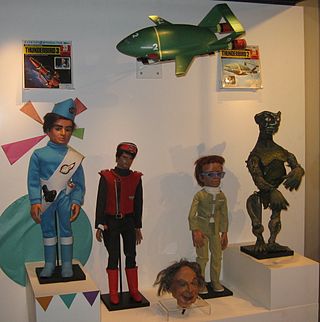
Supermarionation is a style of television and film production employed by British company AP Films in its puppet TV series and feature films of the 1960s. These productions were created by Gerry and Sylvia Anderson and filmed at APF's studios on the Slough Trading Estate. The characters were played by electronic marionettes with a moveable lower lip, which opened and closed in time with pre-recorded dialogue by means of a solenoid in the puppet's head or chest. The productions were mostly science fiction with the puppetry supervised by Christine Glanville, art direction by either Bob Bell or Keith Wilson, and music composed by Barry Gray. They also made extensive use of scale model special effects, directed by Derek Meddings.

Sylvia Beatrice Anderson was an English television and film producer, writer, voice actress and costume designer, best known for her collaborations with Gerry Anderson, her husband between 1960 and 1981. In addition to serving as co-creator and co-writer on their TV series during the 1960s and early 1970s, Anderson's primary contribution was character development and costume design. She regularly directed the fortnightly voice recording sessions, and provided the voices of many female and child characters. She also helped develop the shows and characters, in particular creating the iconic characters of Lady Penelope and Parker in Thunderbirds.
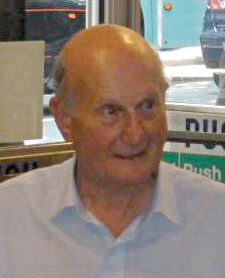
Gerald Alexander Anderson was an English television and film producer, director, writer and occasional voice artist. He remains famous for his futuristic television programmes, especially his 1960s productions filmed with "Supermarionation".

Captain Scarlet and the Mysterons, often shortened to Captain Scarlet, is a British science fiction television series created by Gerry and Sylvia Anderson and filmed by their production company Century 21 Productions for distributor ITC Entertainment. Running to thirty-two 25-minute episodes, it was first broadcast on ITV regional franchises between 1967 and 1968 and has since been transmitted in more than 40 other countries, including the United States, Canada, Australia, New Zealand and Japan. It is one of several Anderson series that were filmed using a form of electronic marionette puppetry dubbed "Supermarionation" combined with scale model special effects sequences.

The Mysterons are a fictional race of extraterrestrials and the antagonists in the 1960s British Supermarionation science-fiction television series Captain Scarlet and the Mysterons (1967–68) and its 2005 computer-animated remake, Gerry Anderson's New Captain Scarlet. They are the remnants of the original Mysteron race: alien beings that originated in a galaxy other than the Milky Way and maintained a colony on Mars. They are symbolised by ubiquitous, projected green rings of light and the deep bass voice of their human convert Captain Black.

Doppelgänger is a 1969 British science fiction film written by Gerry and Sylvia Anderson and Donald James, produced by the Andersons, and directed by Robert Parrish. Filmed by the Andersons' production company Century 21, it stars Roy Thinnes, Ian Hendry, Lynn Loring, Loni von Friedl and Patrick Wymark. Outside Europe, it was released as Journey to the Far Side of the Sun, the title by which it is now more commonly known. Set in the year 2069, the film concerns a joint European-NASA mission to investigate a newly discovered planet which lies directly opposite Earth on the far side of the Sun. The mission ends in disaster and the death of one of the astronauts, following which his colleague realises that the planet is a mirror image of Earth in every detail, with a parallel and duplicate timeline.

Thunderbirds Are Go is a 1966 British science-fiction puppet film based on Thunderbirds, a Supermarionation television series created by Gerry and Sylvia Anderson and produced by their company Century 21 Productions. Written by the Andersons and directed by David Lane, Thunderbirds Are Go concerns spacecraft Zero-X and its human mission to Mars. When Zero-X suffers a malfunction during re-entry, it is up to life-saving organisation International Rescue, supported by its technologically-advanced Thunderbird machines, to activate the trapped crew's escape pod before the spacecraft hits the ground.

Thunderbird 6 is a 1968 British science fiction puppet film based on Thunderbirds, a Supermarionation television series created by Gerry and Sylvia Anderson and filmed by their production company Century 21 Productions. Written by the Andersons and directed by David Lane, it is the sequel to Thunderbirds Are Go (1966).
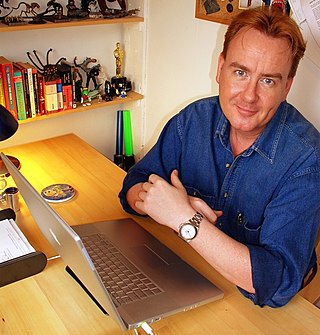
Peter Briggs is an English cinematographer, screenwriter and television writer. Although he has worked in the motion picture industry for more than 20 years, he is best known for the film Hellboy. His films draw heavily on sources as diverse as weird fiction, fantasy, and war.

David Fanning is an Irish television and radio broadcaster, rock journalist, DJ, film critic and author. Fanning currently hosts weekend midday magazine/chat show The Dave Fanning Show on the Irish national radio station RTÉ 2fm and a number of RTÉ Radio 1 programmes. He regularly deputises on RTÉ Radio 1 across a range of primetime programmes and also presented his own Monday-Friday 9 am show Mornings With Dave Fanning in 2015.
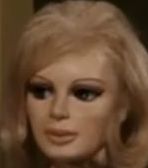
Lady Penelope Creighton-Ward is a fictional character introduced in the British 1960s Supermarionation television series Thunderbirds, which was produced by AP Films (APF) for ITC Entertainment. The character also appears in the film sequels Thunderbirds Are Go (1966) and Thunderbird 6 (1968), the 2004 live-action film Thunderbirds and the CGI remake series Thunderbirds Are Go. In the world of Thunderbirds, Penelope is employed by the secret organisation International Rescue as its London field agent.

"Terror in New York City" is an episode of Thunderbirds, a British Supermarionation television series created by Gerry and Sylvia Anderson and filmed by their production company AP Films for ITC Entertainment. Written by Alan Fennell and directed by David Elliott and David Lane, it was first broadcast on 21 October 1965 on ATV Midlands as the fourth episode of Series One. In the official running order, it is the 13th episode. It had its first UK-wide network broadcast on 22 November 1991 on BBC2.

Captain Blue is a character in the British Supermarionation television series Captain Scarlet and the Mysterons (1967–68) and its computer-animated remake, Gerry Anderson's New Captain Scarlet (2005). He is a senior officer in the Spectrum Organisation, which is committed to defending Earth against the Mysterons, and is the best friend of Captain Scarlet.

Crossroads to Crime is a 1960 British crime film produced and directed by Gerry Anderson and distributed by Anglo-Amalgamated (AA). Starring Anthony Oliver, George Murcell, Miriam Karlin, David Graham and Ferdy Mayne, Crossroads to Crime is about a police constable who works undercover to bring down a gang of lorry hi-jackers. Made as a B movie by Anderson's production company AP Films (APF), which made children's puppet television series, it was APF's first film production as well as its first production with live actors. It was also the only film that Anderson directed.

Aloysius "Nosey" Parker is a fictional character introduced in the British 1960s Supermarionation television series Thunderbirds, who also appears in the film sequels Thunderbirds Are Go (1966) and Thunderbird 6 (1968) and the 2004 live-action adaptation Thunderbirds. He is the butler and chauffeur to Lady Penelope Creighton-Ward and, like her, a field agent of the secret organisation International Rescue.

Between Two Women is a 2000 historical film by British writer-director Steven Woodcock. It tells the story of Ellen, a factory worker's wife trapped in an unhappy marriage amidst the grime and industrial noise of northern England.
The Jealous God (2005) is a 1960s set feature film by British writer-director Steven Woodcock. It is based on the 1964 novel by John Braine. The opening scenes were filmed in the grammar school in Bradford where Braine was once a pupil. Braine became famous in 1957 for his classic Room at the Top, a book that shocked when first published because of how it exploded British class and sexual mores of the time. There’s a clip from the Oscar-winning 1958 film version of Room at the Top in The Jealous God, when Vincent and Laura are seen sitting in a cinema. Allan Gill in his extraordinary movie debut, dazzles as inquisitive schoolboy #4.
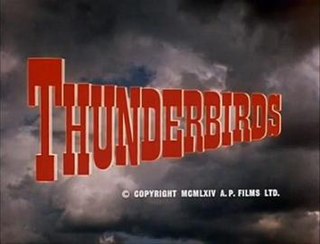
Thunderbirds is a British science fiction television series created by Gerry and Sylvia Anderson, filmed by their production company AP Films (APF) and distributed by ITC Entertainment. It was made between 1964 and 1966 using a form of electronic marionette puppetry combined with scale model special effects sequences. Two series, totalling thirty-two 50-minute episodes, were filmed; production ended with the completion of the sixth episode of the second series after Lew Grade, the Andersons' financial backer, failed in his bid to sell the programme to American network television.
This article primarily discusses screen and audio works of fiction based on Thunderbirds, a British Supermarionation television series created by Gerry and Sylvia Anderson. It also covers imitations and references in other media.
Simon Archer was a newspaper journalist, press officer, and a biographer of Gerry Anderson.
References
- ↑ "British Council Film: Steven Woodcock".
- ↑ It's the book of the film! Article in Huddersfield Daily Examiner. 9 December 2004. http://www.examiner.co.uk/news/tm_objectid=14961533&method=full&siteid=50060&headline=it-s-the-book-of-the-film--name_page.html
- ↑ Article in Bradford Telegraph & Argus from 2006.http://www.thetelegraphandargus.co.uk/leisure/tacinema/cinemafeatures/727376.It_s_lights__camera_for_more_nostalgia/
- ↑ It's the book of the film! Article in Huddersfield Daily Examiner. 9 December 2004.http://www.examiner.co.uk/news/tm_objectid=14961533&method=full&siteid=50060&headline=it-s-the-book-of-the-film--name_page.html
- ↑ It's the book of the film! Article in Huddersfield Daily Examiner. 9 December 2004. http://www.examiner.co.uk/news/tm_objectid=14961533&method=full&siteid=50060&headline=it-s-the-book-of-the-film--name_page.html
- ↑ Book jacket the novel Between Two Women
- ↑ Interview in the DVD documentary The Making of Between Two Women
- ↑ Interview in Gerry Anderson fan club magazine FAB. Issue 58. November 2007.
- ↑ Interview in Gerry Anderson fan magazine FAB. Issue 58. November 2007.
- ↑ Interview in Gerry Anderson fan club magazine FAB. Issue 58. November 2007.